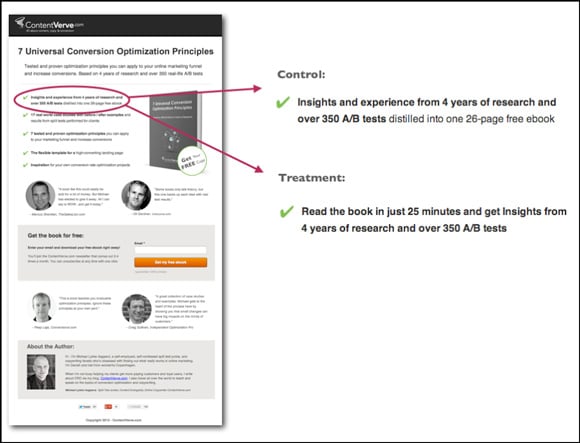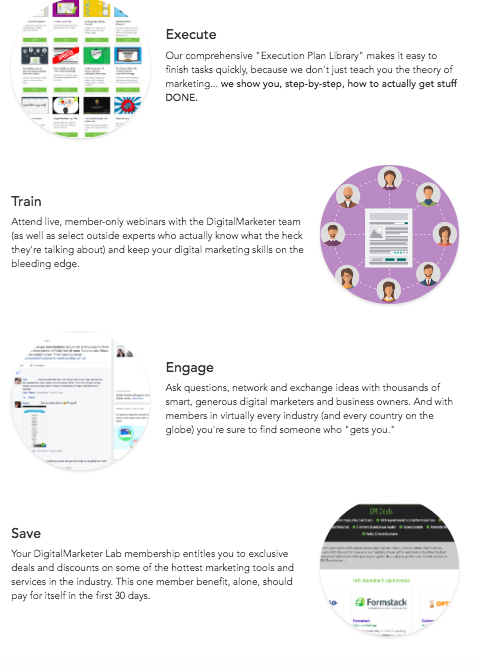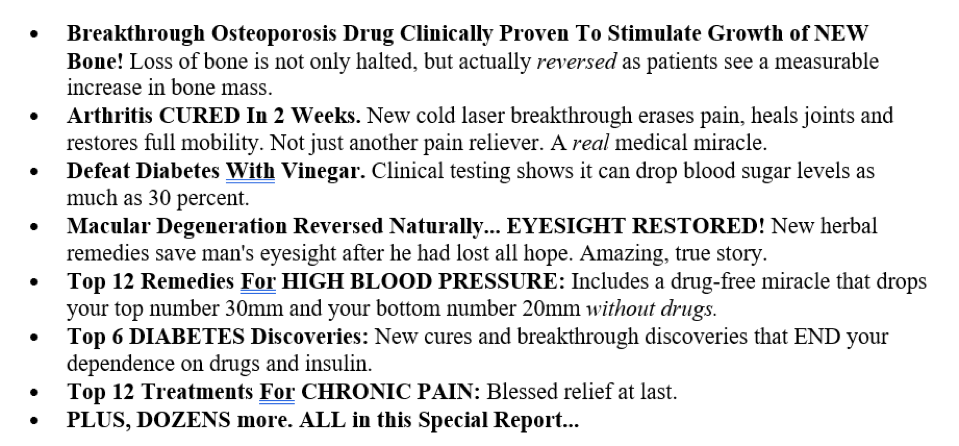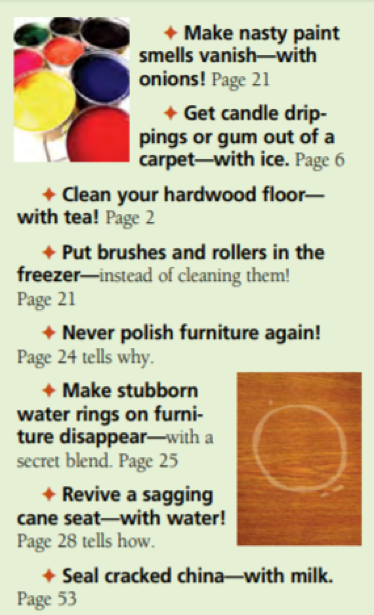This post is a step-by-step checklist for creating powerful, persuasive bullets that make your copywriting stand out.
Why do you need bullets in your copy?
Bullets are teasers, instantly building curiosity and urgency while drawing attention to your product's unique benefits.
Because bullets are short, punchy snippets of text, they're able to engage people even when they aren't reading carefully—which, let's be honest, is most everyone on the web.
Bullets are a powerful conversion element, focusing people's attention on the deep benefits of your product, moving them closer to the sale.
Bullet points...
- Provide clarity and persuasion in one small punch
- Explain features of the product
- Add a "why" to the "what"
- Contextualise your offer to the reader
This is not the time to explain the product or service you are offering. This is the time to outline the benefits your reader will receive if they buy your product or service.
Remember that people don’t buy products and services. They buy outcomes.
- They don’t buy cold medicine, they buy a good night's sleep
- They don’t buy a gym membership, they buy a sexy body
- They don’t buy pest control, they buy a clean, safe home for their children
Here at The Social Lab, we obsess over our bullet points on our landing pages and it takes hours to craft the perfect set.
Check out how this small tweak on a single bullet point increased downloads by 18.59% at a 98% confidence rate.

Test performed by Michael Aagaard.
Here's another example of feature-rich bullet points.

Of course, bullets aren't as easy to write as you might think.
There's an art to creating bullets that drive sales, and if you learn how to do it well, you can be persuasive without resorting to hype. Your bullets can be written in your brand's voice and style (even in "boring" or "straight-laced" industries) and still build desire and drive action.
You may have 3 bullets or a page-full. Generally, short-form landing pages have 3–5 bullets, while long-form sales pages have longer lists. (Some long-form sales pages have 20 to 30 or more bullets!)
That's what you'll learn how to do from this blog post. We'll walk you through a 8-step process for writing sales-boosting bullets that will take your copy from so-so to oh-wow regardless of your voice, style, or industry.
Step 1: Identify Your Product Features
In order to successfully write bullets that increase your sales, you must identify the key features of your product.
This is the nitty gritty of your offer...
- What do you provide to your customer?
- What can they actually DO with your product?
- What does someone gain in exchange for giving you their money?
Your features are the "what" of your product. This step should be very simple at this point because you are just identifying exactly what someone gains when they become a customer. If you don't already know this, stop here and dial in your offer creation.
Here is an example of the type of list you'll create in this step:
- Digital Marketing Consulting
- Conversion Funnel Project Management
- Digital Marketing Team Training
- Corporate Team Training in Digital Marketing
- Customer Journey Consulting
Write the very basic features of the product in column A of the Benefits Analysis Worksheet.
These should be short, punchy statements of exactly what someone gets when they buy your product... we'll get to the "why it matters" later.
Step 2: Complete the Benefits Analysis Worksheet
Bullets are nothing more than a list of benefits that your product's features provide to your customer, written to tease and fascinate your readers so you can move them closer to the sale.
Your aim is to understand which features deliver which benefits, and how. You also want to translate those benefits into tangible improvements to your customers' life and wellbeing.
Once you've written out the product's features, start listing your benefits in the Benefits Analysis Worksheet.
Be specific.
Include as many details as you can.
When brainstorming your benefits, write down the answers to these questions in the corresponding column of the worksheet...
- What are the product's features/specs that make it more useful or valuable to your customers?
- What's the advantages of having access to that feature?
- What motives or desires are satisfied by that advantage?
- What's the outcome, or life change, your customers experience because of that feature? These are your deep benefits
Not all your benefits will go into bullets. Some will, sure. But others may need to be talked about in-depth as part of your sales presentation.

Decide which benefits you'll use in your sales copy (overall), and which ones will get featured in bullets.
Step 3: Write Your Bullets
Bullets are sometimes called "fascinators" for good reason: they condense your benefit into a teaser that builds desire and curiosity.
In this step, we're going to turn each benefit into a teaser.
Be aware, at this stage, we're just trying to write a "rough draft." It's unlikely you'll be able to write a perfect, highly persuasive bullet on your first try. That's okay. We'll edit them to make them more powerful.
Highly successful bullets...
- Highlight a deep benefit your prospect desperately wants.
Drill down to the deep benefits, not the top-level, generic benefits your prospects are likely mentioning. If possible, translate product benefits into life-changing, emotional benefits. For benefits that aren't emotional, aim for something actionable or measurable.
Avoid conceptual or abstract benefits. They're too difficult to explain in just a sentence or two.
2. Differentiate your product as unique.
Give your system, process, type of information, etc. a name so it's proprietary. You might also mention that no one else knows it or does it.
3. Create a sense of urgency or importance.
Urgency sells! If there's a reason your customers need this benefit now, be sure to say so. If the benefit is important to their well-being or happiness, mention it.
4. Focus on specific details, not generalities.
Instead of mentioning generic features and benefits, dial into the details:
Generic: "Cast iron skillets can last a lifetime."
Specific: "Our artisanal, cast iron cookware is made from strictly controlled raw materials in our Småland factory. Made without harmful chemicals, these pans have an exceptionally long-life span, which explains why we provide a 25-year cast iron warranty."
Don't try to format all your bullets the same. It's actually preferable to vary their length and structure.
Here are 3 ways to begin:
- With a number
- With an action verb
- With "how to" or "why"
Structure some bullets as a phrase and others as sentences. Incomplete sentences are totally okay, too.
Use parentheses to add conversational asides and additional information, such as page numbers or modules where information is found, or features that make the benefit possible.
Let's look at some examples:
These bullets aren't perfect (as you'll learn in a minute), but they work well for highlighting the useful information you can find in this book or report. Notice they focus on the specific action or benefit you'll enjoy when you learn this information.

This example is for a training program by master-copywriter Clayton Makepeace. Notice that these bullets are low key and hype-free since they're aimed at a B2B audience who doesn't want to be "sold."

This example is for a physical product, FiberFix Repair Tape Wrap. These bullets start with the deep benefit, then use features and specs as proof elements. The tone is energetic and benefits-oriented, but not hyped.

Step 4: Grade The Bullets
After you've written your bullets, don't assume they're ready.
Your bullets need to meet 3–4 of the qualities we listed of effective sales-boosting bullets:
- Draws out the usefulness of your product ___
- Differentiates your product as unique ___
- Creates a sense of urgency or importance ___
- Specific details (not generic or vague) ___
Go back and grade each bullet you've written. Give it one point for each quality. If it "kinda" meets one of them, you can give it half a point for that quality.
Be aware, it's rare for a bullet to get all 4, but you want it to score at least 2.5 (and if you can't give it a 2.5, scrap it from your list). You can always go back to Task 3 and brainstorm new benefits.
Form your list, identify the bullets that scored at least a 2.5 and identify the area of opportunity to make it more effective. This will be the quality that scored the lowest for each bullet.
Step 5: Edit The Bullets






Step 6: Arrange Your List
Put your strongest bullets at the beginning of your list, and your weakest bullets in the middle. The strength of the bullet is determined by its overall grade after the editing process and the value of the benefit it provides to your customer.
- Place your strongest, most compelling bullets at the top of your list
- Put your next strongest bullets at the end of your list
- Place the weakest bullets in the middle

Step 7: Create Variety
DO
- Vary the length and the structure
- Make some bullets complete sentences and others phrases
- Use parentheses for some
- Use statements AND questions
- Add spacing between bullets or bold alternative lines
DON'T
- Don't make them all look alike

- Get rid of toxic paint fumes right away! Learn how this common kitchen ingredient can help you breathe easy, even if your doors and windows are shut tight. (page 21)
- One simple trick to remove melted candle wax and smushed bubble gum from your carpet. On page 6, you'll learn just how easy it can be.
- Your grandmother may have frowned when she found dust on your furniture, but she didn't know this! Here's why you need to throw away your furniture polish today—and what to do instead. (You won't believe it! And neither will Grandma.)
- How to seal cracked china. We'll tell you how on page 53.
Step 8: Write Your Transitions
Create a transition into and out of your bullets.
Something like…
- Here's everything you'll get:
- As one of Nick's students, you'll get everything you need to succeed:

%20(1).png?width=300&height=112&name=Copy%20of%20The%20Social%20Lab%20(2)%20(1).png)



Comments